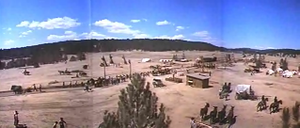How the West Was Won (film)
The film centers on a family and their descendents over the span of decades as they explore and settle the American frontier of the United States.
Originally filmed in true three-lens Cinerama with the according three-panel panorama projected onto an enormous curved screen, the film features an ensemble cast formed by many cinema icons and newcomers, including (in alphabetical order) Carroll Baker, Lee J. Cobb, Henry Fonda, Carolyn Jones, Karl Malden, Gregory Peck, George Peppard, Robert Preston, Debbie Reynolds, James Stewart, Eli Wallach, John Wayne and Richard Widmark.
The supporting cast features Brigid Bazlen, Walter Brennan, David Brian, Andy Devine, Raymond Massey, Agnes Moorehead, Henry (Harry) Morgan, Thelma Ritter, Mickey Shaughnessy and Russ Tamblyn.
[3] At the 36th Academy Awards it earned eight nominations, including Best Picture, and won three, for Best Story and Screenplay Written Directly for the Screen, Best Sound and Best Film Editing.
In 1997 it was selected for preservation in the United States National Film Registry by the Library of Congress as being "culturally, historically, or aesthetically significant".
When the lead raft is caught in rapids, Zebulon and his wife Rebecca drown; Linus arrives to help bury them.
Eve's sister Lilith chooses to go back east, dreaming of becoming rich, and years later becomes a singer and dancer in St. Louis.
While performing at a music hall, she attracts the attention of professional gambler Cleve Van Valen, who learns that she has just inherited a California gold mine.
When the war ends, Zeb returns home as a lieutenant and learns his mother died, having lost the will to live after losing Linus.
Zeb serves in the U.S. Cavalry, trying to maintain peace with the Native Americans with the help of buffalo hunter Jethro Stuart, an old friend of Linus's.
When railroad man Mike King violates a treaty by building on Native American territory, the Arapahos retaliate by stampeding buffalo through his camp, killing many.
Disgusted by Mike's unchecked greed and callousness, Zeb resigns from the army, and then visits Jethro at his mountain cabin before moving on.
Satisfied by the prosperous life she shared with Cleve, she travels to Arizona, inviting Zeb and his family to oversee a cattle ranch, her last remaining asset.
Deciding he must act, Zeb suspects Gant plans to rob a train's gold shipment, and prepares an ambush with Ramsey's reluctant help.
[7] In 1960, MGM struck a deal to produce four films in the Cinerama process, and Bing Crosby approached the studio with a proposition.
"[14] By April 1961, Wayne and Spencer Tracy had confirmed their plans to play Generals Sherman and Grant for a segment directed by John Ford, and James Stewart had been signed as well.
[15] Other roles would go to Gregory Peck, Debbie Reynolds, Russ Tamblyn and Carroll Baker, while Henry Hathaway and George Marshall would also direct from a script by James Webb.
Ultimately, the film contained five sections: the 1830s westward migration, the 1849 California gold rush, the Civil War, the construction of the transcontinental railroad, and the "taming" of the Wild West, with one family's story over three generations providing the bridge between each time period.
[18] How the West Was Won was one of only two dramatic feature films (along with The Wonderful World of the Brothers Grimm) produced with the three-strip Cinerama process.
Throughout the movie, one of the basic themes is to show little people against a vast country – huge deserts, endless plains, towering mountains, broad rivers.
[20] Parts of the film were shot in Monument Valley, Utah[21] and in Wildwood Regional Park in Thousand Oaks, California.
[22][23] Ford complained about having to dress such huge sets, as Cinerama photographed a much wider view than did the standard single-camera process to which Hollywood directors were accustomed.
Ford initially objected, but Peppard felt that it was important in such a long, sprawling film to remind the audience which character his father was supposed to be.
After the film was shot, MGM ordered a new ending that resolved the family story, which caused shooting to continue for another month and included George Peppard and Debbie Reynolds.
Dimitri Tiomkin, known for his Western film scores, was the first composer approached, but he became unavailable following eye surgery and Newman was hired as a replacement.
Debbie Reynolds sings three songs in the film: "Raise a Ruckus Tonight" starting a party around the camp fire, "What Was Your Name in the States?"
Surprisingly for such an American film, How the West Was Won had its world premiere in the United Kingdom at London's Casino Cinerama Theatre on November 1, 1962.
Previously, the lines where the three Cinerama panels join were glaringly visible, but this has been largely corrected on the Warner Bros. DVD and Blu-ray releases.
For instance, in the final shot, the Golden Gate Bridge appears to curve in perspective as the camera flies underneath it whereas in the Cinerama version, it breaks into three straight sections at different angles.






